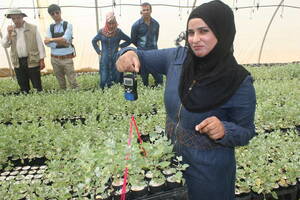The vital contribution of women to livelihoods resilience during COVID-19

By Dina Najjar and Bipasha Baruah
The 2020 International Day of Rural Women's theme is "Building rural women's resilience in the wake of COVID-19." Through a survey carried out with 100 male and 100 female dryland farmers in rural Egypt and Tunisia, we examine how COVID-19 affected them, and identify coping mechanisms they employed to maintain crop and livestock supplies, sales, market connections, and personal wellbeing. Since dependence on digital resources increased during the pandemic, we paid close attention to trends in cellphone ownership, access, and preferred means for receiving digital information.
Impact on sales, inputs, and services
Livestock
COVID-19 lockdowns disrupted veterinary services and livestock sales in both countries. Market closures and suspension of transport services coincided with the national Adha holidays, usually the most profitable time of the year for livestock farmers. Farmers in both countries managed to sell some livestock to local butchers but incurred overall losses.
The sale of milk and dairy products at local collection points continued in both countries, albeit in lower quantities and hence lower profit margins. Because local markets were closed, women who usually sold milk and dairy products were severely affected. However, some Egyptian women responded to the reduction in milk sales by processing milk into ghee, cheese, and other dairy products with longer shelf lives. In Tunisia, women responded to reduced milk sales by donating milk to neighbors in crisis and by selling milk from home at lower prices. When lockdowns lifted, sales of milk and dairy products recovered, but so far only to 85% of pre-pandemic sales.
Both countries experienced disruption in livestock feed supplies because of price increases during the pandemic, which farmers attributed to traders' monopolies. Male farmers responded by traveling to multiple locations within and beyond their communities in search of better prices, which some farmers secured at bigger shops in Egypt. Female farmers in Egypt responded to feed shortages by relying on corn feed, which is more readily available. In Tunisia, male and female farmers responded to feed shortages by allowing livestock to graze farther on rangelands and for extended periods. Chicken sales plummeted during the pandemic in both countries due to suppressed markets. Female farmers responded to drops in chicken sales by diverting more chicken supplies for domestic consumption.
Crops
Crops supplies and sales were less poorly affected during the pandemic than livestock. In Tunisia, farmers reported labor shortages due to the reduced mobility of laborers induced by suspensions of public transport and to the challenges of maintaining physical distancing requirements on farms. Procuring labor for lower-paid tasks such as weeding that women usually perform was identified as particularly challenging during the pandemic. It led (alongside reduced access to herbicides because of market closures) to increased workloads for the women that made it to work. Some farmers were unable to plant vegetables due to labor shortages.
Male farmers reported limited disruptions in the sale of fava beans in Tunisia and peanuts in Egypt due to market inaccessibility. They are storing the crops until markets recover and prices improve, so depending on the pandemic duration, it remains to be seen if this is an astute coping strategy. In Tunisia, women reported a drop in usually lucrative sales in local markets of harissa (red pepper paste) and aromatic oils. Selling from home for lower prices was identified as a temporary coping strategy.
Digital Extension Services
In Tunisia, fewer women (50%) surveyed than men (83%) own cellphones. In Egypt, female graduates who had independently received plots of land from the government for farming were more likely to own cellphones than any other category of female farmers. In Tunisia, the ability to conduct phone interviews with female farmers was curtailed by women's lower cellphone ownership rates. Some female farmers were reached, albeit only through their husbands' consent and cellphones. Male and female farmers in both countries identified radio and television as other preferred modes for receiving agricultural information.
Personal Wellbeing
In Tunisia, women reported increased workloads as a result of needing to "disinfect everything that entered the home." Male farmers emphasized increased expenditure due to the purchase of cleaning products and increases in feed prices. In both countries, women (sometimes from the same households as men) more often than men reported increased domestic tensions due to male job losses, a decrease in sales, or increases in household expenses. This finding confirms that perceptions and experiences of intrahousehold dynamics and tensions can differ markedly based on gender.
Women – the hidden backbone of rural farming?
Because women perform most of the labor of livestock rearing and retain control over sales of milk and meat in local markets, fluctuations in prices and supplies of these commodities affect them more than men.
Given women's significantly lower rates of cellphone ownership in both countries, digital interventions deployed during the pandemic, and indeed at any time, run the risk of excluding women if the exclusive focus remains on cellphones, so digital interventions should be diversified to include radio and television.
Figuring out ways to improve market access while complying with public health guidelines is also essential given the losses female farmers have incurred due to COVID-19-induced market closures. Although our survey and phone interviews did not provide any evidence of increased domestic violence during the pandemic, additional qualitative research may yield different results.
Regulating access to consistent and affordable supplies of feedstock and other agricultural inputs is an essential first step to resilience building. This is particularly important given the resurgence of COVID-19 in the MENA region (and the possibility of future lockdowns and market closures).
The study uncovers the often undervalued and hidden contribution that women make to rural dryland farming practices. It suggests that building women's resilience to the impact of COVID-19 and even afterward, through better transport, consistent and affordable supplies of feedstock and other agricultural inputs, digital access, and on domestic issues, is a good place to start for strengthening the resilience of households and whole communities. Given the global resurgence of COVID-19 and its expected long-term effects, now, more than ever, we should not overlook what women are already offering.
The full report will be published soon.
READ MORE ABOUT ICARDA'S GENDER WORK
----------------------------
Study authors:
Dina Najjar is a Gender Scientist with ICARDA in Rabat, Morocco
Bipasha Baruah is a Professor and Canada Research Chair in Global Women’s Issues, University of Western Ontario, Canada
--------------
This research is funded by UN’s IFAD CLCA Phase II project, CRP PIM, and CRP Livestock.




